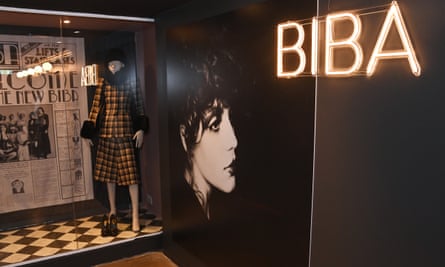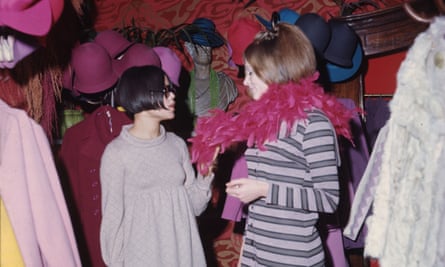Long before millennial pink walls and neon slogan signs filled people’s lives, there was Biba, one of the world’s first lifestyle brands. Now, 49 years after the legendary emporium shut its doors for the final time, the Fashion & Textile Museum in London is paying homage with a new retrospective, The Biba Story, 1964-1975.
The brainchild of Barbara Hulanicki and her husband, Stephen Fitz-Simon, it evolved from selling clothing via mail order to offering everything from Biba-branded makeup to pet food and tins of baked beans from the sprawling seven-storey art deco building it occupied on Kensington High Street from 1973 until 1975.
 View image in fullscreen
View image in fullscreen
Filled with antique ornate furniture, the clothes for sale were tossed on coat stands and surrounded by dimly lit feathered chandeliers. A Mistress room sold underwear and silk sheets, the restaurant/nightclub Rainbow room featured a ceiling lit with the colours of the rainbow, and on the rooftop shoppers could sip tea next to pink flamingos perched by a pond. On Saturdays, the queue curved its way along the high street, with customers ranging from teenagers to the Rolling Stones and Twiggy.
Curated by Martin Pel, the aim of the exhibition is, he says, to capture “just how fabulous Biba was”. Much of that fabulousness stems from Hulanicki. Born in Poland in 1936, she grew up in Palestine before moving aged 12 to England to live with her aunt after her diplomat father was assassinated. Now aged 87, she resides in Miami but has returned to London for the opening.
Many of the hundreds of pieces on display have come from the attics of former “Biba girls”, including Hulanicki’s first shop manager. Items range from a leopard-print coat designed for Twiggy in 1973 to devoré wrap dresses, and Hulanicki remembers sketching every single piece.
A short pink gingham shift dress based loosely on the one Brigitte Bardot wore in Saint-Tropez in 1963 opens the show. It is the dress that changed the course of Hulanicki’s life, pivoting the mail order fashion business she had co-founded with Fitz-Simon into the spotlight fafter its appearance in a fashion spread in the Mirror newspaper. On the same day, 17,000 readers placed orders.
 View image in fullscreen
View image in fullscreen
It was Fitz-Simon, a former advertising executive, who suggested keeping the price point low. He discovered the average secretary took home £10 a week: £3 could buy them a new dress in Biba and still leave them with plenty of change for rent and food. Hulanicki, who previously worked as a fashion illustrator for newspapers, knew there was a gap in the market for affordable and fun clothing. The fashion shows in Paris, which she had experience of covering, were, she says, “terribly boring”. “The clothes were so frumpy. It was all old lady clothes. I thought, ‘God, I’m earning money and I can’t even buy anything that I like’.”
Although Biba was quick to churn out new designs each week, Hulanicki says the brand’s approach was vastly different to today’s world of fast fashion. “The Biba girls saved up and planned their outfits. They re-wore and held on to everything.”
 View image in fullscreen
View image in fullscreen
She blames the introduction of launderettes for changing the fashion landscape. “Before you washed everything by hand, suddenly people were throwing wool coats into machines. They ruined so many pieces. So then the big chains started creating fabrics that were durable such as polyester. Now there’s clothing piles full of the stuff.”
skip past newsletter promotionSign up to Fashion Statement
Style, with substance: what's really trending this week, a roundup of the best fashion journalism and your wardrobe dilemmas solved
after newsletter promotion
She loves the gen Z approach to secondhand shopping, which she has come across on Instagram. “It’s amazing what they find. You can even get Gucci bags for next to nothing.” She still enjoys keeping up with trends. The “mob wife” aesthetic gets a nod of approval but she disliked many of this season’s catwalk looks. “All those boobs and bums hanging out and all that transparency, it’s horrible.”
 View image in fullscreen
View image in fullscreen
Hulanicki’s own micromini designs were an accident. They missed out the vital step of leaving the jersey fabric to rest when cutting it out. As a result, the fabric slowly shrank. “Fitz called me to say, ‘I don’t know what’s happening but the skirts are shrinking before my eyes’. We thought it would be a disaster but they flew out the door.”
Pel is still getting phone calls from original shoppers offering to lend him pieces. “Barbara changed the way people shopped. The exhibition is about Biba but it’s also about the camaraderie Barbara created amongst women.”
The Biba Story, 1964-1975 runs from 22 March 2024 to 8 September 2024.

